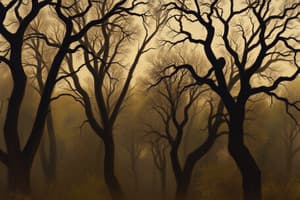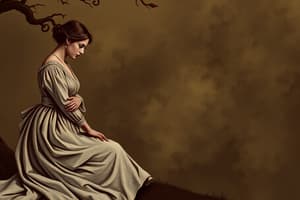Podcast
Questions and Answers
Match the notable features of Romanticism with their descriptions:
Match the notable features of Romanticism with their descriptions:
Individualism = Emphasis on personal feelings and emotions over rational thought Politcal and cultural nationalism = Celebration of local customs and native languages Interest in ruins = Fascination with death, decay, and the macabre Formal experimentation = Breaking away from classical rules in art and literature
Match the Romantic poets with their respective countries:
Match the Romantic poets with their respective countries:
Johann Wolfgang von Goethe = Germany Lord Byron = United Kingdom Friedrich Schiller = Germany Percy Bysshe Shelley = United Kingdom
Match the Romantic movements with their significance:
Match the Romantic movements with their significance:
Spanish Romanticism = Brief period followed by Realism Sturm und Drang = Initial stirrings of Romanticism in Germany Gothic novels = Exploration of horror and the grotesque Cultivation of the fantastic = Influence from journalism on serialized works
Match the key characteristics of Romanticism with their examples:
Match the key characteristics of Romanticism with their examples:
Match the Romantic ideals with their explains:
Match the Romantic ideals with their explains:
Match the notable figures with their contributions or characteristics in the Romantic movement:
Match the notable figures with their contributions or characteristics in the Romantic movement:
Match the regions with their characteristics during the Romantic movement:
Match the regions with their characteristics during the Romantic movement:
Match the poetic styles with their descriptions:
Match the poetic styles with their descriptions:
Match the authors with their notable works:
Match the authors with their notable works:
Match the periods with their notable traits:
Match the periods with their notable traits:
Flashcards
Romanticism definition
Romanticism definition
A literary and artistic movement (late 18th to mid-19th century) reacting against the Enlightenment's focus on reason, emphasizing passion, nature, and individual expression.
Romanticism's origins
Romanticism's origins
Started in Germany and the UK in the late 1700s, with figures like Goethe, Schiller, Byron, and Shelley.
Romanticism's opposition to
Romanticism's opposition to
Neoclassicism's emphasis on reason and logic in art.
Romantic features: Individualism
Romantic features: Individualism
Signup and view all the flashcards
Romantic features: Nature
Romantic features: Nature
Signup and view all the flashcards
Spanish Romanticism Peak
Spanish Romanticism Peak
Signup and view all the flashcards
Late Romantic Poetry in Spain
Late Romantic Poetry in Spain
Signup and view all the flashcards
Spanish Romantic Theatre
Spanish Romantic Theatre
Signup and view all the flashcards
Spanish Costumbrismo
Spanish Costumbrismo
Signup and view all the flashcards
Romantic Period in Puerto Rico
Romantic Period in Puerto Rico
Signup and view all the flashcards
Study Notes
Romantic Period in Literature and History
- Romantic period emerged at the end of the 18th century, following Neoclassicism, lasting through the mid-19th century.
- The term "romantic" is often used to mean sentimental or passionate. It's used in popular media like TV shows, movies and music, but the Romantic Period in literature and art had a different meaning.
- It was a reaction against the political, social and intellectual climate of the 18th century.
- In literature, it opposed the rules of Neoclassicism, which emphasized logic and reason.
Key Characteristics of Romanticism
- Individualism and Subjectivity: Emphasis on the individual's emotions and experiences over reason.
- Primacy of Emotion over Reason: Individual passions were prioritized over logic and reason
- Nationalism: Focus on national cultures and languages, often celebrating traditional customs.
- Historical Interest: Fascination with the past, particularly for mythical and historical figures.
- Intense Interest in Nature: Romantic writers often saw nature as a source of inspiration and beauty.
- Interest in the Supernatural and the Mysterious: Including fascination with the dark and horrifying aspects of life.
- Idealization of the Past: Romantic writers often idealized past societies.
- Rebellion against Established Authority: A common theme was rejection of social conventions and authority
- Hero as a Genius: Idealized figure, often misunderstood and facing struggles in a world that didn't understand him/her.
- The Expressiveness in Form: Romantic writers experimented with form and style, freely using language.
- Combination of Beauty and Ugliness: Romantic aesthetics frequently explored the tragic alongside the comic.
- The Power of Landscape and Nature: Romantic writers portrayed nature in dramatic or symbolic detail, reflecting the writer's soul.
Regions and Examples of Romanticism
- Germany: Goethe and Schiller (Sturm und Drang movement)
- England: Byron, Shelley, and Mary Shelley
- Byron's Childe Harold's Pilgrimage
- Spain: Romantic period considered late and brief between 1835 and 1850. Examples include the Duke of Rivas, José de Espronceda, Gustavo Adolfo Bécquer, and José Zorrilla.
- Latin America: Romantic works emerged significantly between 1810 and 1890.
- Important figures included José María Heredia and José Esteban Echeverría.
- Puerto Rico: The Romantic period in Puerto Rico was also late, emerging between 1843 and 1880. Characterized by the pursuit of national independence.
Studying That Suits You
Use AI to generate personalized quizzes and flashcards to suit your learning preferences.




